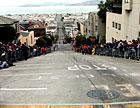1st BMC San Francisco Grand Prix - 1.4San Francisco, USA, September 9, 2001Live Report Results and report Preview and Start list How the race was run (and where it'll get us)There's a lot more to organising a major urban bike race than inviting a bunch of racers to turn up. Mark Shahinian found out the background and the politics behind the SF Grand Prix.
But of more significance than the scenery, if the race organizers have their way the San Francisco race could be the start of a resurgence of professional road racing in major U.S. cities. Deep-pocketed sponsors, aggressive promoters and a willing city government came together to make the San Francisco race happen. The race's 16.6 kilometer course is a way to showcase the city and bring big-time bike racing to the United States, said Dan Osipow, US Postal Service team director of operations and vice president of Tailwind Sports, the company jointly promoting the Grand Prix. "The [San Francisco] Bay area is one of the premier cycling regions in the country," Osipow said. "We are dead set on making this a top-quality event internationally." For a handful of local pro and amateur racers, the San Francisco Grand Prix was an unusual chance to compete on their own turf — most big races in the United States are on the East Coast, 3,000 miles away. "Since the day this [race] was announced, I have been super excited about it," said Tim Larkin, a dominant local amateur who competed in the race. "It's something you always hope for over the years." Tailwind would like, Osipow said, to set up similar one-day events in cities such as Denver, Washington, D.C. and Los Angeles. Bay area-based Tailwind and its partner Threshold Sports are handling most of the race details, from street barriers to porta-potties. Not everyone is convinced the San Francisco race signals a wider change in U.S. racing. The popularity of road racing in the U.S. peaked after the 1984 Olympics and again after LeMond's Tour victories in the late 1980s, as Lance Armstrong himself pointed out at a pre-race press conference Friday. "It seems like [cycling's popularity] rides the wave of the successes of its riders," Armstrong said. Lining up television coverage and willing sponsors was key to making the race happen, Osipow said. The local ABC television affiliate, KGO-TV, planned to air five hours of racing. KGO President and General Manager Joe Ahern said Lance Armstrong's Tour de France successes and the number of cyclists on local roads piqued Ahern's interest in racing. Ahern admitted his station may not make money on the race this year, but said he hopes the race can survive to become an annual event. Texas-based BMC Software agreed to put up a big chunk of the more than US$1 million race budget. BMC sponsors bike races in cities with large technology industries to recruit both customers and employees, said Dan D'Armond, BMC's manager for government and community relations. "There's a lot of chief executive officers out there who are avid cyclists and a lot of people in the technology industry who are avid cyclists," D'Armond said.
Brown spokesman P.J. Johnston said the city is approached about - and turns down - a number of sporting events each year, including proposals for auto races. However, a bike race is a good fit for a city with a history of bicycle advocacy and progressive politics, Johnston said. Plus, San Francisco is using the race to promote tourism, a major industry here, and to sell its tentative bid for the 2012 Olympic Games. "We love the thought of having views from the Marina, from the Embarcadero, from North Beach beamed all over the country, all over the world," Johnston said, referring to several of the city's neighborhoods. According to Osipow, the race's start/finish line was placed in the Embarcadero because Brown wanted to showcase the urban renewal work that has gone on there. But at least some members of the San Francisco Police Department expressed dissatisfaction with the way the decision was made to hold the race. "Uniquely in San Francisco, the police department had no input" in the decision to hold the race said San Francisco Police Sgt. Mike Flynn. The police are using close to 500 officers to cover the race and some say in how the race was organized would have been nice, Flynn said. The police costs for the race will be absorbed in the city's yearly budget, and the net cost to the city for the race will be in the "tens of thousands of dollars," Johnston said. "Does an event like this mean extra work on the part of city employees? Absolutely," Johnston said. "Does this administration think it's worth it? Absolutely." Mark Shahinian is a freelance writer based in the San Francisco Bay area. He can be reached at markshahinian@hotmail.com. |

